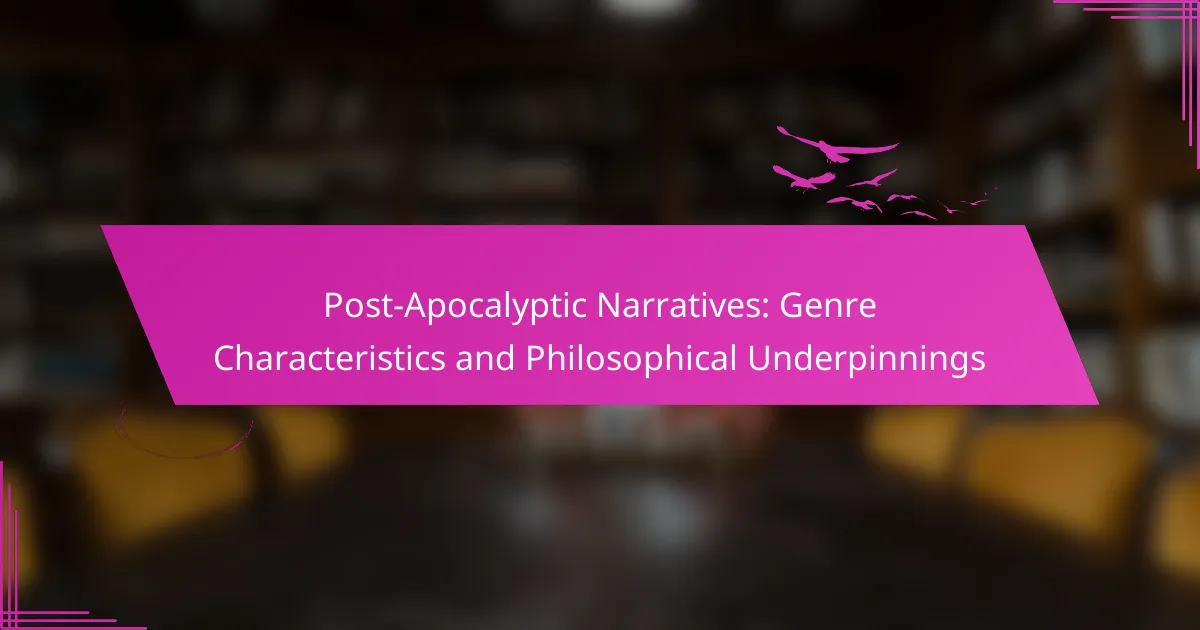Post-apocalyptic narratives delve into survival, societal collapse, and human resilience. They feature devastated worlds, moral dilemmas, and character development. Philosophical themes explore existence and morality, reflecting contemporary anxieties. Cultural influences and unique narrative techniques further enrich these stories, highlighting the human condition amidst chaos.
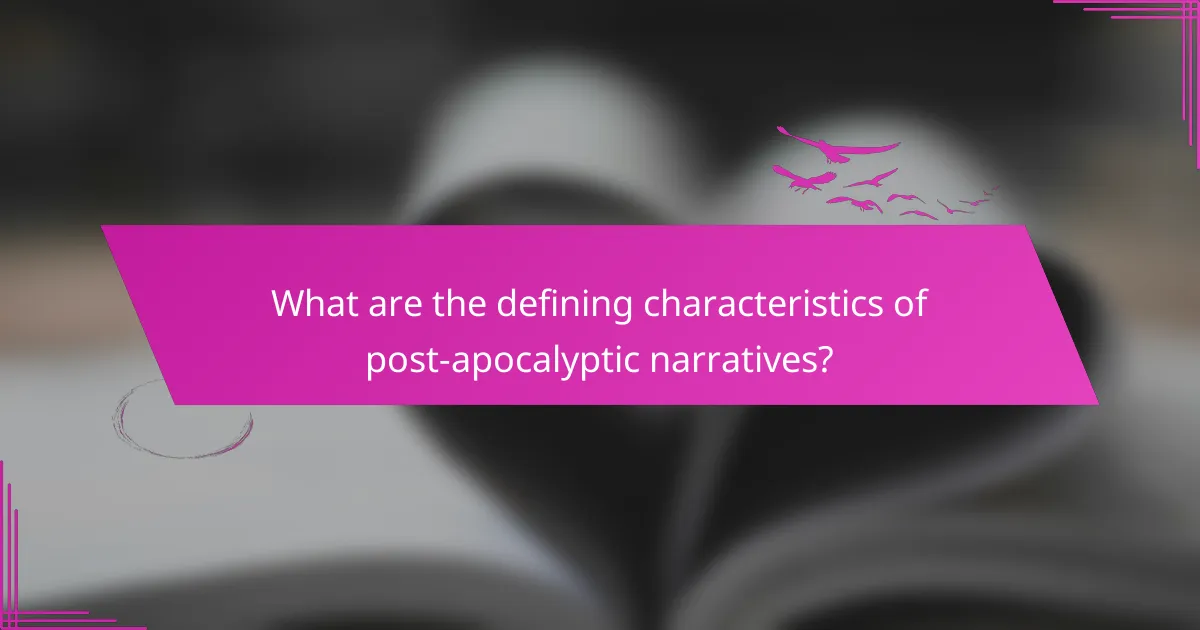
What are the defining characteristics of post-apocalyptic narratives?
Post-apocalyptic narratives often explore themes of survival, societal collapse, and human resilience. They typically feature a devastated world, moral dilemmas, and the struggle for hope. Key characteristics include a focus on character development, exploration of human nature, and the impact of environmental or technological disasters. These narratives frequently challenge philosophical questions about morality, existence, and the essence of humanity in extreme circumstances.
How do settings influence the tone and themes of these stories?
Settings significantly influence the tone and themes of post-apocalyptic narratives by establishing mood and context. Desolate landscapes often evoke feelings of despair, while remnants of civilization can spark themes of hope or survival. The stark contrast between nature reclaiming urban environments and the struggles of humanity shapes character motivations and moral dilemmas. For example, isolated settings may highlight themes of loneliness, while communal survival can emphasize cooperation and resilience. The unique attributes of each setting, such as climate or geography, further enrich the narrative, deepening the philosophical underpinnings of humanity’s place in a changed world.
What role do characters play in shaping post-apocalyptic plots?
Characters are essential in shaping post-apocalyptic plots by driving emotional depth and moral dilemmas. They embody the struggle for survival, often reflecting societal values and human resilience. Unique attributes of characters, such as their backstories and motivations, influence plot progression and thematic exploration. The interactions among characters reveal the complexities of human nature in extreme circumstances, making the narrative compelling and relatable. As a result, character development is crucial for engaging audiences and enhancing the overall impact of the story.
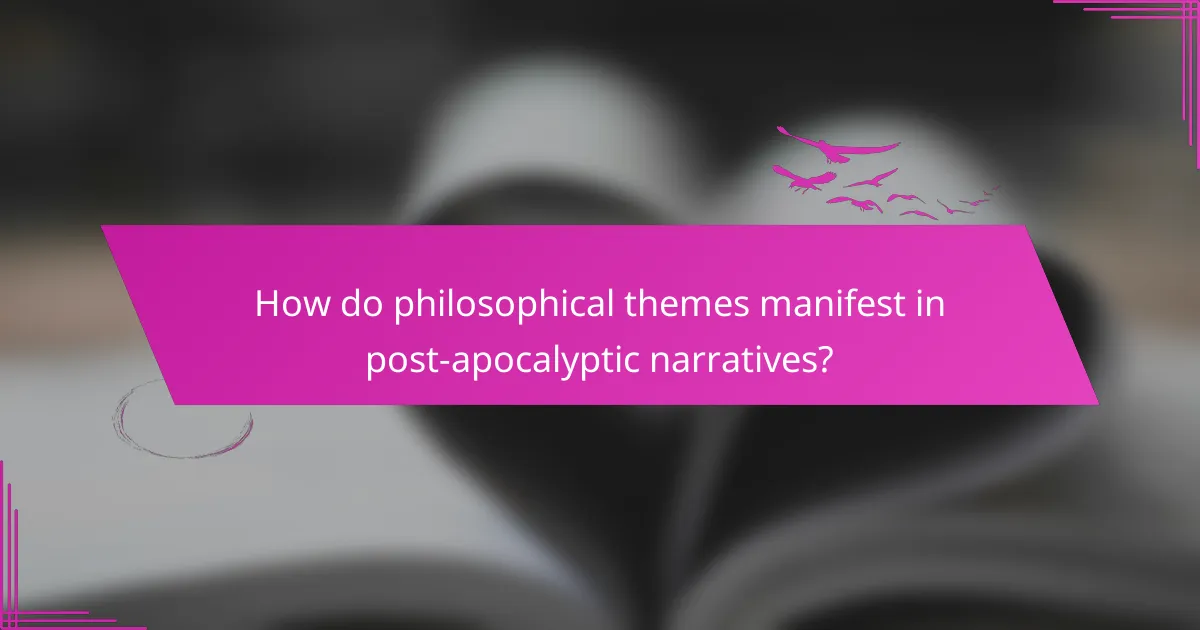
How do philosophical themes manifest in post-apocalyptic narratives?
Philosophical themes in post-apocalyptic narratives often explore human existence, morality, and societal structures. These narratives frequently examine the fragility of civilization and the essence of humanity when stripped of societal norms. Common themes include existentialism, which questions the meaning of life in a desolate world, and the moral dilemmas faced in survival situations. The unique attribute of these narratives is their ability to reflect contemporary anxieties, such as environmental collapse and technological overreach. As a result, they serve as cautionary tales that provoke deep philosophical reflection on human nature and our collective future.
What existential questions are commonly explored in this genre?
Post-apocalyptic narratives often explore existential questions about humanity’s purpose, survival, and morality. Common themes include the nature of existence in a devastated world, the essence of human connection, and the ethical dilemmas faced in extreme circumstances. These stories frequently interrogate what it means to be human when societal structures collapse, prompting characters and readers alike to reflect on identity, choice, and the value of life. Additionally, the genre examines the consequences of human actions, often questioning whether redemption is possible in a bleak future.
How does morality evolve in post-apocalyptic scenarios?
Morality in post-apocalyptic scenarios often shifts towards survival and community cohesion. As societal structures collapse, individuals prioritize immediate needs and ethical decisions become more situational.
Survival instincts dominate moral choices, leading to a pragmatic approach where traditional ethics may be abandoned. Characters often face dilemmas that challenge their previous moral frameworks, reflecting unique attributes of human nature under extreme conditions.
Community dynamics play a crucial role in moral evolution. Groups may establish new codes of conduct, influenced by shared experiences and the need for cooperation. This can lead to rare moral philosophies emerging, focused on collective welfare rather than individual rights.
Ultimately, post-apocalyptic narratives explore the fluidity of morality, revealing how circumstances can reshape ethical beliefs and behaviors. These stories invite reflection on the nature of humanity and the principles that govern our actions in crisis situations.
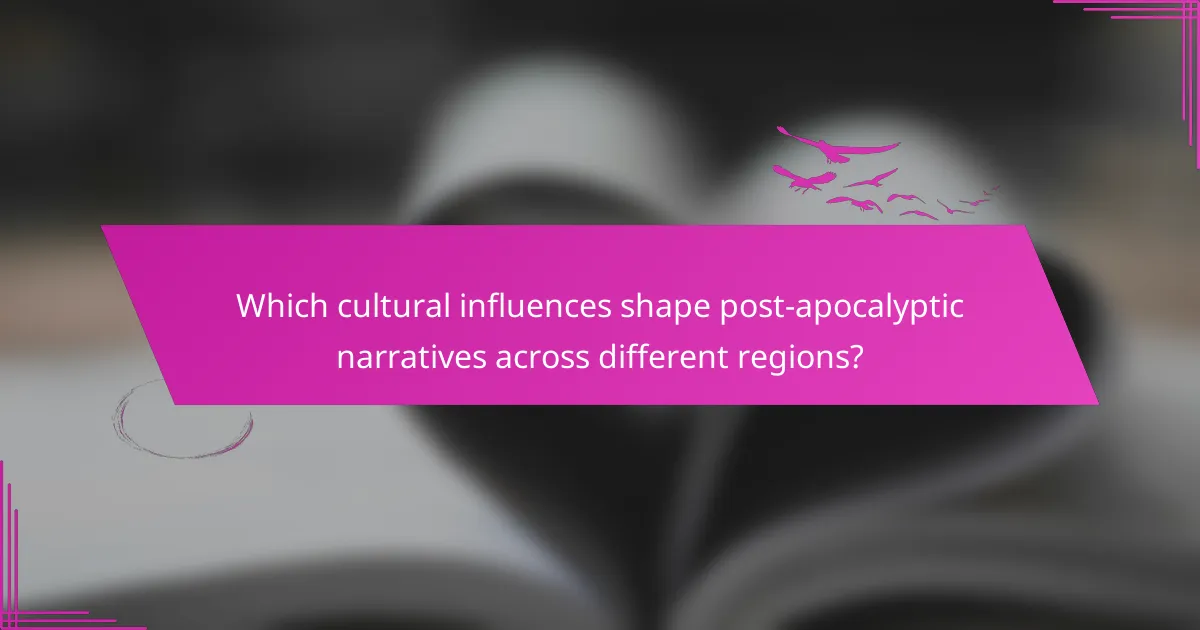
Which cultural influences shape post-apocalyptic narratives across different regions?
Cultural influences such as mythology, historical events, and societal fears shape post-apocalyptic narratives. For example, Western narratives often reflect anxieties about technology and individualism, while Eastern narratives may incorporate themes of collectivism and nature’s resilience.
Mythological elements frequently appear, drawing from local legends to create unique worldviews. In Japan, narratives often emphasize the relationship between humanity and nature, influenced by Shinto beliefs. In contrast, American narratives may focus on survivalism, reflecting a unique cultural ethos.
Historical events, like wars or pandemics, also inform these stories. The Cold War significantly impacted Western narratives, instilling fears of nuclear annihilation. Conversely, regions affected by colonialism may explore themes of oppression and resilience, showcasing the struggle for identity in a post-apocalyptic world.
Overall, post-apocalyptic narratives serve as a mirror, reflecting the cultural values and fears of different societies while addressing universal themes of survival and humanity.
How do societal fears and anxieties reflect in these stories?
Societal fears and anxieties manifest in post-apocalyptic narratives through themes of survival, loss, and moral ambiguity. These stories reflect collective concerns about environmental degradation, societal collapse, and technological overreach. As a result, they often explore human resilience and the fragility of civilization. Unique attributes include the portrayal of dystopian landscapes and the psychological impact on characters, highlighting how fear shapes human behavior in extreme circumstances. Such narratives serve as a mirror to contemporary anxieties, prompting reflection on current societal issues.
What role does technology play in the portrayal of post-apocalyptic worlds?
Technology significantly shapes the portrayal of post-apocalyptic worlds by enhancing visual storytelling and deepening thematic exploration. Advanced graphics and virtual reality create immersive environments, allowing audiences to experience desolation and survival firsthand. Drones and AI can depict the vastness of abandoned cities or the remnants of civilization, emphasizing isolation. Additionally, technology influences narrative structures; interactive storytelling engages viewers, making them active participants in the unfolding chaos. This blend of technology and narrative fosters a deeper understanding of human resilience and societal collapse, reinforcing philosophical themes inherent in the genre.
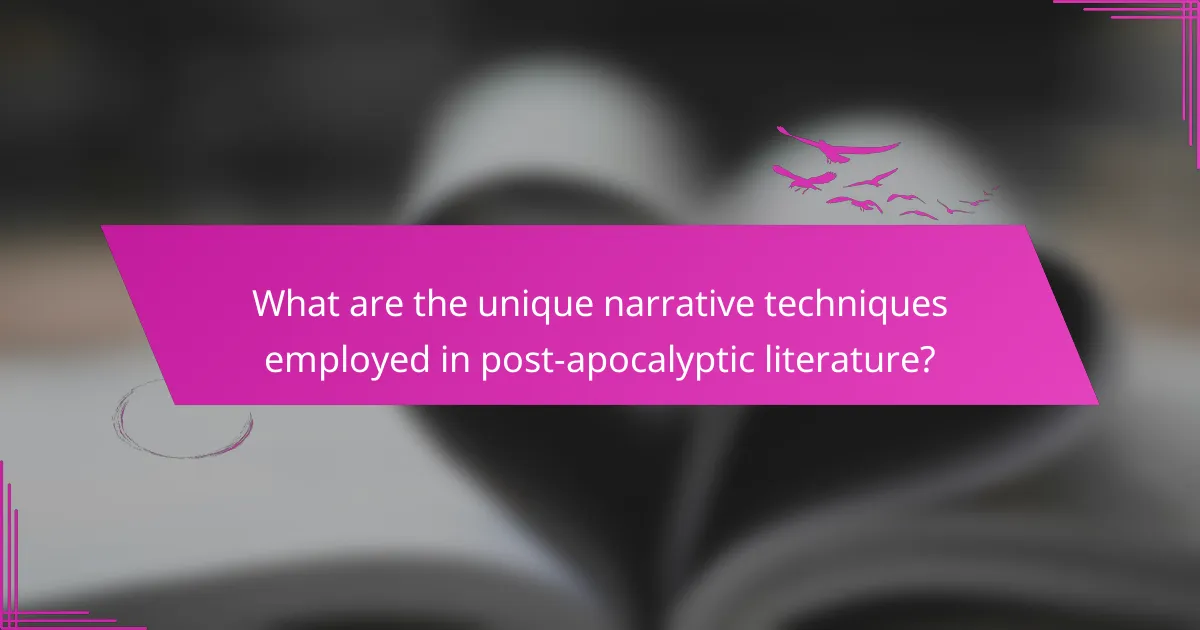
What are the unique narrative techniques employed in post-apocalyptic literature?
Post-apocalyptic literature employs unique narrative techniques that emphasize survival, isolation, and the human condition. These techniques include fragmented storytelling, which reflects disorientation; unreliable narrators, creating ambiguity about truth; and non-linear timelines, enhancing tension. Additionally, vivid world-building immerses readers in desolation, while character-driven plots explore moral dilemmas. Themes of hope and resilience often emerge, illustrating the human spirit’s endurance amidst chaos.
How do authors create immersive worlds in their storytelling?
Authors create immersive worlds in post-apocalyptic narratives by developing rich settings, complex characters, and philosophical themes. These stories often explore human resilience, moral dilemmas, and societal collapse.
Key characteristics include detailed world-building that evokes a sense of loss and decay. Authors use vivid descriptions to create a tangible atmosphere, often drawing on sensory details. Unique attributes may include the depiction of survival tactics and resource scarcity, which heighten tension and engagement.
Philosophical underpinnings often reflect on existential questions and the human condition. Themes of hope, redemption, and the struggle for identity in a transformed world resonate deeply with readers. This complexity allows for a diverse exploration of moral choices, often leading to profound character development.
The interplay between setting and character actions emphasizes the psychological impact of a post-apocalyptic environment. Authors effectively use these elements to create a lasting emotional connection with their audience, making the narrative both immersive and thought-provoking.
What is the significance of non-linear storytelling in this genre?
Non-linear storytelling is significant in post-apocalyptic narratives as it enhances thematic depth and character development. This structure allows for fragmented timelines, reflecting the disarray of a world after catastrophe. By presenting events out of order, authors can emphasize emotional resonance and the psychological impact of survival. This approach also invites readers to piece together the narrative, fostering engagement and critical thinking. Ultimately, non-linear storytelling mirrors the chaotic nature of post-apocalyptic existence, enriching the overall experience.
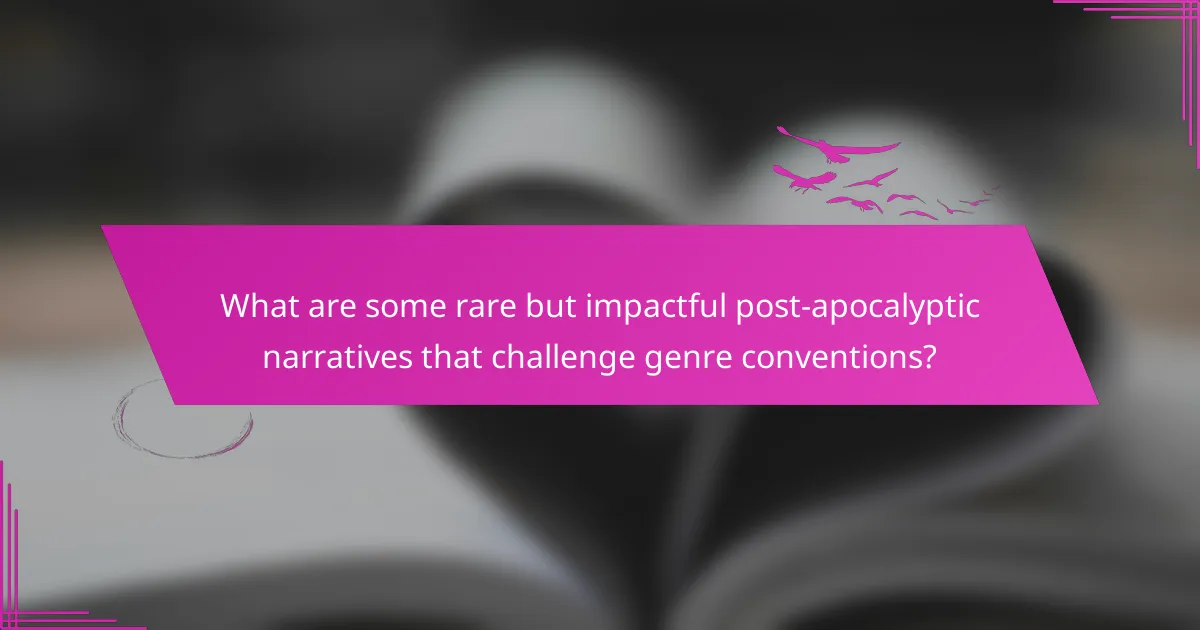
What are some rare but impactful post-apocalyptic narratives that challenge genre conventions?
Some rare post-apocalyptic narratives challenge genre conventions by integrating unique philosophical themes and unconventional storytelling. Works like “The Road” by Cormac McCarthy focus on the emotional bond between father and son, emphasizing human connection over survival. “Station Eleven” by Emily St. John Mandel explores the role of art and memory in rebuilding society, presenting a more hopeful vision. “Parable of the Sower” by Octavia Butler features a protagonist with a unique belief system, challenging traditional narratives of despair. “The Dog Stars” by Peter Heller blends survival with introspection, highlighting the importance of companionship. These narratives redefine post-apocalyptic themes, moving beyond mere survival to explore deeper human experiences.
How do these stories differ in their approach to survival and human nature?
Post-apocalyptic narratives differ in their approach to survival and human nature by emphasizing distinct philosophical themes. Some stories focus on individualism, showcasing characters who must rely solely on their instincts and skills to survive. Others highlight community and cooperation, illustrating how human connections can foster resilience in dire circumstances. Additionally, narratives may explore moral dilemmas, revealing the complexities of human nature under stress. The portrayal of hope versus despair also varies, influencing characters’ motivations and actions. These differences create a rich tapestry of interpretations regarding survival and the essence of humanity.
What can be learned from unconventional post-apocalyptic narratives?
Unconventional post-apocalyptic narratives often challenge societal norms and explore human resilience. These stories reveal unique perspectives on morality, survival, and community. They question traditional values, prompting readers to reflect on contemporary issues. For instance, narratives may depict diverse characters overcoming adversity, emphasizing empathy and cooperation. This shift from typical hero archetypes highlights the complexity of human nature in crisis. Overall, such narratives encourage deeper philosophical inquiry into the human condition.
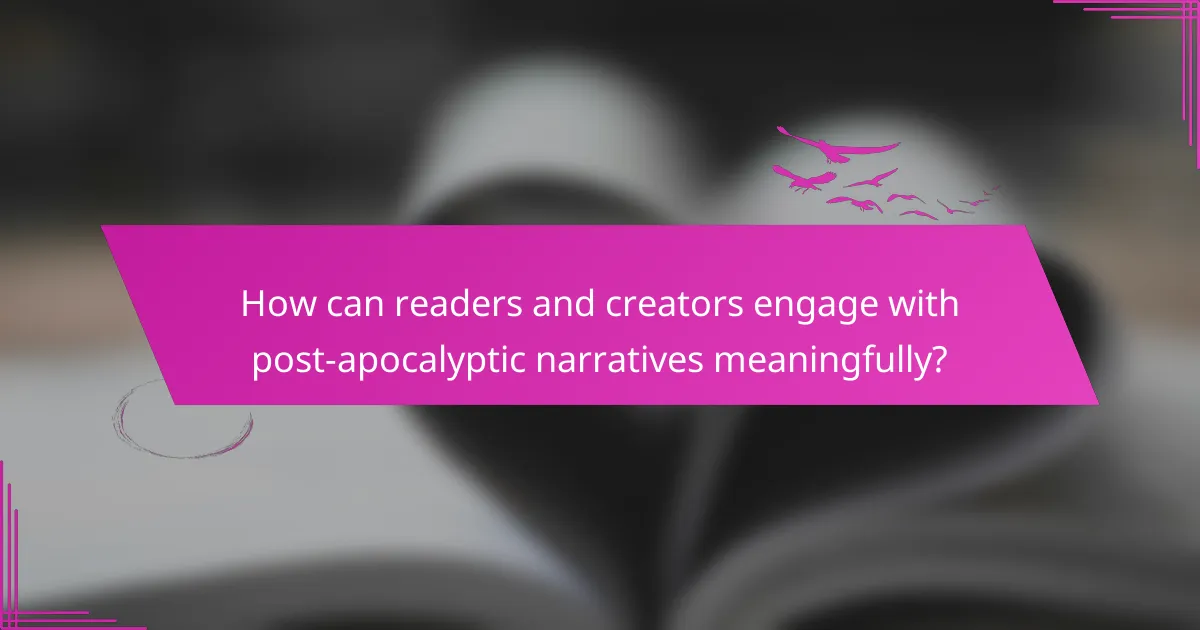
How can readers and creators engage with post-apocalyptic narratives meaningfully?
Readers and creators can engage with post-apocalyptic narratives by exploring themes of survival, morality, and societal reconstruction. These narratives often provoke deep philosophical questions about human nature and resilience.
Engagement can occur through various methods:
1. **Discussion Forums**: Participating in online communities to analyze character motivations and plot developments.
2. **Creative Writing**: Crafting original stories or fan fiction that expands on existing worlds.
3. **Artistic Expression**: Creating visual art or music inspired by the themes and aesthetics of the genre.
4. **Critical Analysis**: Writing essays or reviews that explore the philosophical implications and societal critiques present in these narratives.
Each method fosters a deeper understanding of the genre’s unique attributes, such as its exploration of dystopian realities and the human condition. Engaging meaningfully enhances appreciation and encourages critical thought about the implications of such narratives on real-world issues.
What are the best practices for writing compelling post-apocalyptic stories?
To write compelling post-apocalyptic stories, focus on character development, world-building, and moral dilemmas. Create relatable characters facing extreme challenges to evoke empathy. Develop a rich, immersive world that reflects societal collapse, incorporating unique attributes like scarce resources. Explore philosophical themes such as survival, humanity, and ethics, using rare attributes to deepen narrative complexity. Engage readers with suspenseful plots that highlight the struggle for hope in despair, ensuring every element reinforces the central entity of the narrative.
What common pitfalls should be avoided in this genre?
Common pitfalls in post-apocalyptic narratives include over-reliance on clichés, neglecting character development, and ignoring world-building details. These issues can result in predictable plots and shallow experiences. Failing to explore philosophical themes may also weaken the narrative’s impact. Engaging with unique attributes of the genre can enhance depth and originality.
